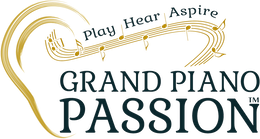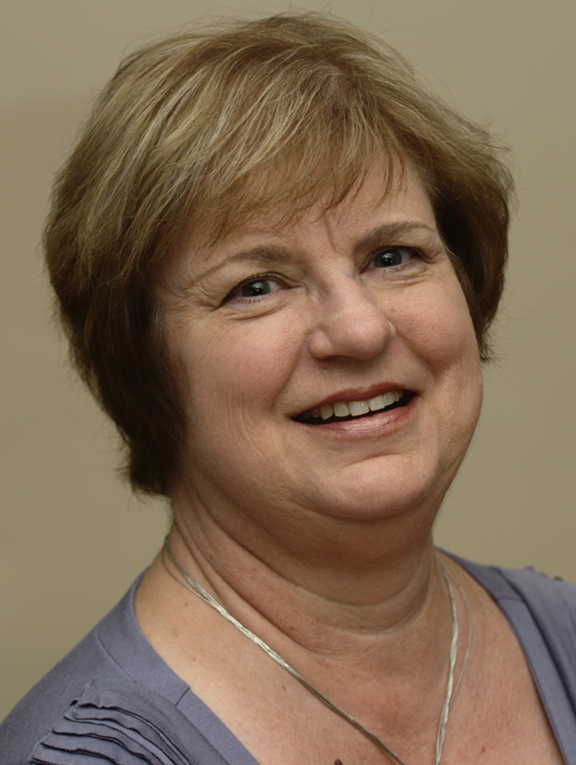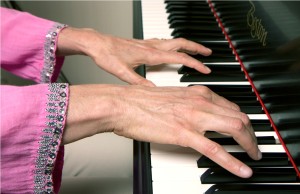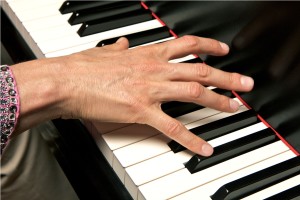Sometimes when students remain stuck with a teacher ill-suited to their needs, the results may be more dire than expected. Twenty years ago, Dr. Gail Fischler dropped out of her piano performance masters program, with no plans to finish her degree. Today, she is a prominent piano teacher, an instructor at Eastern Arizona College, and a respected speaker on piano pedagogy. She also runs Piano Addict, a website for piano lovers of all ages: students, teachers, friends, amateurs, and professionals.
Gail’s story shows the frustrations of studying under an approach mismatched to her learning style. She recently joined me for this interview exclusive to GRAND PIANO PASSION™.
Please tell us about the teachers throughout your studies who really stand out.
I would say that Pat Meierotto, my teacher at San Jose State University, really revolutionized my experience with the piano. He was the first teacher who got me thinking about the pieces I was playing. With him, it was not just about notes and technique; it was about connecting to the music.
It sounds like that was a wonderful experience.
Yes. But when I went on to the University of Arizona for my master’s in piano performance, I took lessons from Ozan Marsh. I learned a lot about pedaling from Ozan, and I am grateful for it. I had never learned to use direct pedal and pedal effects, and I hadn’t played brilliant études before I studied with him. But his way of teaching was extremely regimented and not very much fun at all.
How so?
You had the metronome and you did each two-measure or four-measure section over and over again. You started 30 notches down from your desired tempo, and then gradually you worked up to your desired speed.
That’s how you would learn the music? He would tell you to practice two to four measures at a time, over and over?
That’s it. And if you didn’t do it, boy were you in trouble! It would literally be every tempo on the metronome, so you know, if you started down at 50, the next would be 52 and 54 and 56 and 58 to 60, 63… see, I still have them memorized.
I don’t know if I could have handled that very well.
I was really unhappy then because I had recently found a way to emotionally connect with the music, courtesy of my previous teacher, and I felt like that skill was being taken away from me. What frustrated me was that if you remove the whole emotional content and you just focus on these little tiny segments, often you have to re-learn the whole piece again once you’ve learned the notes.
So did you stick it out with Mr. Metronome?
No. I actually adjourned my graduate studies for 15 years. I finally graduated in 2000 and then continued on to a PhD program.
Do you think that if you had not had Ozan Marsh as a teacher you might not have stopped your studies?
It’s hard to say. There is indeed the possibility that the young Gail was immature musically and in life experience and not ready to get to the next level. I do know for sure, though, that I felt caged and frustrated by his system.
So what happened when you returned to the University?
I studied on and off with Rex Woods, and to supplement that, I would fly once a month to Las Vegas to take lessons with Carol Stivers at the University of Nevada. We would have these marathon lessons that lasted three to four hours.
That’s incredible! What made it worth your while to fly all the way to Las Vegas for piano instruction?
Carol brought a new set of repertoire, including Messiaen, to me and encouraged me to discover new and current repertoire on my own. She taught me different ways to roll large chords that fit with a composer’s intent for a passage. Let’s say, for example, you have a four-note left-hand chord, spread over a 10th or more, which is supposed to be thunderous. Rolling the chord may weaken the sound. Carol showed me how I could play the lowest three notes together and then sneak in the top one, so that the attack is heard as one strong event.
Did the fact that Carol is a woman—while all of your previous teachers were men—play a role in the chemistry between you two?
Possibly. There’s the old saying, “when you really need a teacher, the one you need will appear.” Well, she did. I do think that there was a difference in having a woman teacher. I think that genetics or culture sometimes influences the way men and women approach learning and technique. Perhaps finally studying with a woman helped validate my musical instincts.
How have your experiences shaped your teaching style, especially with adult piano lessons?
Well, it seems like many of the adult students I meet have never really found their own voices. I encourage my students to make their own musical decisions. Sometimes it’s just one phrase in the whole piece where I hear their voice, and if I’m lucky enough to capture it, I can call it to their attention and build on it.
What would you advise to other piano teachers who are considering taking adults into their practice?
Generally, you have to be flexible because adults juggle a lot of things in their lives. You also have to let them have more control than a young child, and I think sometimes you have to let them work things out before you jump in and fix something. All in all, with adult piano students, it’s a much more equal role.





Ozan Marsh Method:
Did he have you practice longer sections tempo by tempo?
Ever whole piece at each tempo?
Every piece learned this way?
Did it work for certain pieces?
Just curious! Thanks! Russell
Thank you, Russell. Great questions! We’re reaching out to Gail to see if she can supply more information.
Here’s the response we received from Gail Fischler. Hope this helps!
Hi Russell,
Great question! Actually we divided every single piece into 4 measure sections. After we learned a large section of the piece then we combined four measures into 8 and then 12 etc. until we had the larger sections in the form all together. Those were then combined into the whole piece. When learning this way it is important to begin and end at least one note before and beyond a section. That way there are no hard transitions. You begin 30 tempos under your final goal and begin with the first 10. When you have accomplished the first 10 you move to the second 10 and so on. it’s interesting that there are some tempos where you hit the wall and just fail. But, the tempos beyond it are just peachy. Must be neurological and possibly unique to everyone. For me, this system definitely does not work for every piece. The rigidity of the metronome becomes too ingrained and I need to make music even at slow tempos or I am an unhappy camper. That said, I do use the system at least the first 20 tempos for areas that are technically falling apart and music that is just hard to learn. I also always divide pieces into sections and learn and combine them as mentioned even when not using a metronome. I use the metronome often to check my rubato and make sure it serves the music and not my technical shortcomings. Using the larger architectural sections, I also practice every other one of the original approximate 4 bar sections singing, ghosting, or imagining the skipped ones to ensure continuity in performance. (play 1, imagine 2, play 3, imagine 4 etc. then reverse) In other words, so I can keep going no matter what. Here is an article to give you more information about how I practice. https://pianoaddict.com/2016/06/building-habits-or-correcting-mistakes/
Thanks, Gail